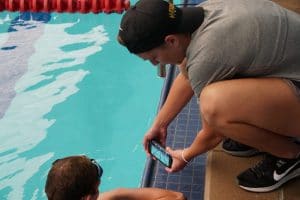All, welcome back to Part II of our series on Breaststroke Undulation. Last week, we discussed the different types of Breaststroke Pull Techniques. This week, we plan to dive deeper into the two Breaststroke Pull Techniques and how that affects your Breaststroke Undulation.
Let’s get started!
With Breaststroke being a short-axis stroke, it requires a swimmer to undulate (or move) around their hips. You have to undulate to swim Breaststroke, but the amount of undulation you do can vary between swimmers.
In last week’s post, we deciphered the difference between the Fast Recovery and DPS Breaststroke Pull Techniques – and I’m sure within both of those techniques you’ve assumed there is a difference in their undulation styles…that is correct!
The Fast Recovery:
In the Fast Recovery Breaststroke Pull Technique requires a swimmer to swim with a FAST Tempo. The ironic part about this stroke is that most coaches would assume that with a Fast Tempo – swimmers wouldn’t be able to get that high out of the water while swimming, but that’s actually not true.
Swimmers who swim with a Fast Recovery Breaststroke focus on undulating MORE, than swimmers who swim with a more DPS stroke.
Why?
The Fast Recovery stroke is all about turnover and power generation. In order to actually recover with a Fast Recovery, you don’t want a swimmer to politely put their head back down under the water after the breath – you want them to aggressively do that, so they can get to their next stroke!
When you couple the force from throwing the head/chest back down with the legs snapping backwards, swimmers achieve a higher peak speed, than if you did those movements individually or not at all.
The higher a swimmer can undulate the more distance they have to throw their body down, and the ability they have within that distance to generate a bigger speed. It’s a win-win overall!
The faster you go through your recovery, and the higher you can get – means you can achieve a quicker Breaststroke stroke.
Virtual Coaching Spots Available:

Swim Like A. Fish now offers virtual coaching for individuals and groups. Virtual Coaching includes Dryland/Strength Training and Swim Coaching. To learn about all our virtual coaching options, click the button below!
The DPS Stroke:
As we already mentioned, the DPS Stroke doesn’t require as much undulation compared to the Fast Recovery. You do have a tendency to see this stroke using undulation heights across the board through. Some swimmers may use very little undulation, while others may use a lot.
The video below is a great example of different undulation styles within a DPS Breaststroke stroke:
The ones who use a lot do it for similar reasons as the Fast Recovery Breaststrokers, and the ones who do it a little – stay low to conserve their energy and hold their breath longer while in their bodyline.
What’s best for you?
Hopefully after last week’s post, you’ve figured out whether you are a Fast Recovery or DPS Breaststroker. Within that, you either need to be on A LOT of undulation if you’re a Fast Recovery Breaststroker or you need to find that sweet spot of undulation for yourself if you are a DPS Breaststroker.
Be sure to keep an eye out for next week’s post, where we help the DPS Breaststroker figure out how MUCH undulation they should aspire to have so they can continue to hit a beautiful bodyline!
Until Next Time,
Abbie Fish

4 Responses
Very inspiring! Will try both on my swimmers!
Enjoy!!
This is great! Thank you
Thank you! I appreciate it!